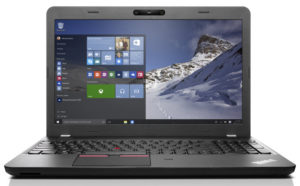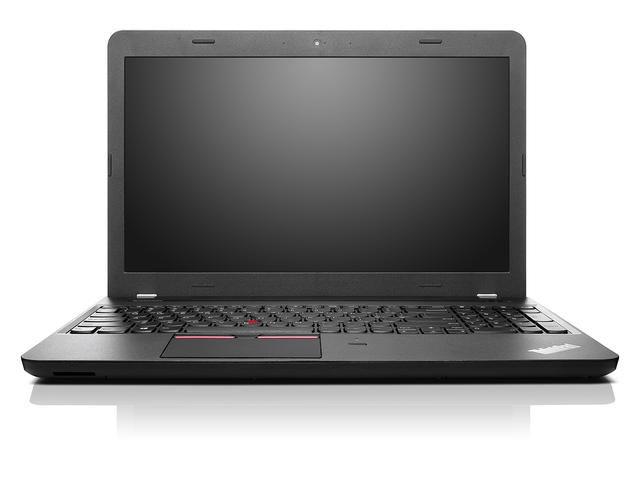Lenovo ThinkPad E560 review – the first E-series laptop to have an IPS panel
 The Lenovo ThinkPad line has never targeted consumers looking for extravagant or attractive design, instead of this Lenovo’s target is this group of people who desire serious looks for serious work without unnecessary elements or details. In fact, we can label its looks as traditional and iconic as the line has preserved its characteristic fatures for more than 20 years, and every rumour of there being a change in its style is not at all welcomed by its fans.
The Lenovo ThinkPad line has never targeted consumers looking for extravagant or attractive design, instead of this Lenovo’s target is this group of people who desire serious looks for serious work without unnecessary elements or details. In fact, we can label its looks as traditional and iconic as the line has preserved its characteristic fatures for more than 20 years, and every rumour of there being a change in its style is not at all welcomed by its fans.
Today we shall have a look at a new model from the ThinkPad E-series, which is as impressive as its predecessor mostly in terms of its quality, with the difference that there is a suprise this time – this is the first Lenovo laptop from the series to have an IPS screen. This should make it a wonderful helper not only for the traditional business tasks but also for color editing, as well as photo manipulation, for example. In the same time, you receive an exceptional multimedia station that provides more satisfying experience while watching movies or looking at the photos from your trips or hobbies, in your spare time.
Naturally, Lenovo ThinkPad E560 is in accordance with the latest trends and is equipped with an Intel Skylake CPU (from the last, 6th generation), as well as discrete GPU, which in our case was AMD’s Radeon R7 M370.
You can find out more about its price here: http://amzn.to/1ShjKgl
Contents
What’s in the box?
The laptop we received is a test unit and it did not have manuals or a specific charger model. Nonetheless, we are sure that you will receive an AC adapter, charging cable and user manual, apart from the device itself.
Design and construction
As we mentioned above, the design of the ThinkPad models concentrates mainly on simplistic appearance and sturdy construction. This model is not an exception to the rule. The first thing that we noticed was the hinges holding the screen – they are made of metal, and a single-hand attempt to open the notebook will not be very easy. We would rather consider this as a plus – it is almost certain that they will remain stable and secure during the next few years.
Once the laptop is open, you can see typical interior that we spoke about earlier. Your attention is attracted by the red TrackPoint, positioned in the midst of the keyboard and in this way substituting the touchpad’s function for cursor control. It is namely this way of operating on the machine that is preferred by most of the old Thinkpad consumers, and we can say that in certain situations it really is more convenient, if you are used to it.
The touchpad itself is placed several centimeters below and it occupies a distinguishably big area, needed because of the gestures it supports. Touch it one time and it interprets a left-button click, touch it two times and you get a right-button click. Thus, the simple design is preserved, as the presence of buttons as physical elements would be confusing as there are three buttons in the TrackPoint group – a left, right and a scrolling button.
The 15″-size of the ThinkPad E560 has allowed the integration of a NumPad module which will be a plus for the consumers who frequently work with figures and calculations. Below the module we notice the compulsory “ThinkPad” inscription, and next to it the fingerprint scanner. Not all E560 models have this perhaps best and easiest way of entering a password of their very own, but it was present in our unit.
The keyboard has the same old design – the Fn button occupies the place of the Ctrl button (their functionality can be swapped in BIOS), the “smiling” keys called “AccuType” as well as the vast number of function keys for quick access all contribute to comfortable working conditions.
ThinkPad E560 provides a large number of ports – on the left, there are two USB SS (3.0) ports, HDMI, VGA, Ethernet, and a Kensington Lock. On the right, there are the DVD drive, one USB SS port, and the charging port of your device.
Display and sound
Lenovo ThinkPad E560 features a Full HD matte IPS screen. It has a diagonal of 15.6″ (39.62 cm) and a resolution 1920 x 1080 pixels. Its aspect ratio is 16:9, the pixel density is 141 ppi and the pixel pitch is 0.18 x 1.18 mm . The panel can be considered as “Retina” if viewed from a distance equal or greater than 61cm (from this distance the eye can not differentiate the separate pixels and it is normal for looking at a laptop).
Lenovo ThinkPad E560 has comfortable viewing angles. We present photos from a 45-degree incline for the purpose of quality evaluation.
We measured high average maximum brightness before calibration – 321 cd/m2, with 14% of deviation on the surface of the screen. The average temperature value, measured on white screen and maximum brightness is 6570K and coincides with the optimum (6500K) light.
Color reproduction
The following diagram displays the spectrum of the sRGB color space (that has been used by millions of people in HDTV and the Web) covered by the screen of Lenovo ThinkPad E560. Starting with the CIE 1976 Uniform Chromaticity Diagram that represents the visible spectrum of colors by the human eye giving you a better perception of the color gamut coverage and the color accuracy. Inside the black triangle, you will see the standard color gamut (sRGB) used in HDTV and the Web – rec.709/sRGB, while the wider Adobe RGB color space is used by professional cameras and images meant for printing. Basically, colors inside the black triangle are used by everyone and their precise representation is crucial for the quality of the screen.
The yellow triangle delineates the capabilities of the Lenovo ThinkPad E560. The coverage of 49% of sRGB is insufficient for saturated colors.
The input-output gamut-curve displaying the distribution of brightness levels coincides with the accepted standard 2.20 after calibration.
We calibrated the screen to brightness level of 140 cd/m2 and target temperature of 6500К.
We used X-Rite i1Display Pro as a tool for calibration.
We tested the screen using 24 colour samples, which contained common colors as well as colors that are easily discernible by the eye – dark and light human skin, blue sky, grass green, orange peel, for example. Their accuracy is high, avg DeltaE 2000 = 0.90. The contrast ratio is 950:1 before and 810:1 after calibration.
Part of the colors from the screen verification report are graphically presented in the histogram below.
Pulse-width modulation (PWM, Screen flickering)
The screen of Lenovo ThinkPad E560 uses PWM for controlling brightness levels only up to 60 cd/m2 (46% Brightness). In this way it does not harm the eyesight in the most common work modes (the range is 80-200 cd/m2).
Conclusion
The screen of Lenovo ThinkPad E560 has high resolution and accurate colors as per ColorChecker. It features comfortable viewing angles, contrast levels are relatively good, but the sRGB coverage is poor. It does not affect the eyesight with pulsations in a normal working mode. It is suitable for video playback, web browsing, gaming and various business applications (not connected to colour processing).
Sound
A subjective sound test of Lenovo ThinkPad E560 showed very good and powerful stereo sound. The lows and the mids are clear, while the highs provide mellow and pleasing tones without noticeable deviations. The result from the apmplitude-frequency characteristics confirm this. They display wide frequency range in the +/- 6 dB range, which indicates a carefully designed sound tract.
Specs sheet
| CPU |
|
|---|---|
| RAM |
|
| GPU |
|
| HDD/SSD |
|
| Display |
|
| Optical drive | DVD burner |
| Connectivity | LAN 10/100/1000 Mbps, Wi-Fi 802.11ac, Bluetooth 4.0 |
| Features |
|
| Battery | 6-cell, 48Wh |
| Weight | 2424 gr (battery included) |
| Thickness | 23.8 до 27.1 mm |
Software
Our review unit has a pre-installed Windows 10 OS. If you happen to need additional drivers you can download them from Lenovo’s official website.
Battery
Lenovo ThinkPad E560 has a 6-cell 47520 mWh (48Wh) battery, which is normal for multimedia-oriented mid-range models. Despite the presence of a low-voltage processor, we don’t expect very high results, because the GPU’s power consumption is not low, especially with an IPS panel. We conducted our usual test in real-life conditions – web browsing, gaming and HD video playback with the following settings: Wi-Fi turned on, and “Power saver” mode set to 120cd/m2 screen brightness.
Web browsing
In order to simulate real-life conditions, we used our own script for to automatically browse through over 70 websites.
We weren’t much surprised by the battery and got only 3 hours and 58 minutes.
Video playback
For every test like this, we use the same video in HD.
Now, this result is interesting! Even though it did not reach 4 hours of web browsing, in the video test we registered 5 hours and 16 minutes.
Gaming
To ensure an accurate gaming situation, we used the Metro: Last Light benchmark with graphics settings set to low.
Without a charger (even though this may not sound as a good idea), the gaming result was good – 1 hour and 35 minutes.
CPU

Intel Core i7-6500U is part of the Skylake generation processors and it’s entitled to the ULV lineup (ultra-low voltage) with 14nm FinFET manufacturing process. It has two cores that support Hyper-Threading technology resulting in up to 4 threads. The chip is a direct successor to the Core i7-5500U Broadwell CPU expecting slightly better performance with emphasis on the power efficiency features.
The CPU is clocked at 2.5 GHz and can go up to 3.1 GHz for one active core or 3.0 GHz for two active cores. Also, the silicon includes an Intel HD Graphics 520 iGPU that sports 24 Execution Units ticking at 300 MHz and can go up to 1.05 GHz. The whole SoC supports DDR4-2133/DDR3L-1600 memory in a dual-channel array. So the whole chip is rated at 15W TDP including the memory controller and the integrated graphics thus making it suitable for 11-inch notebooks or bigger. It also supports the cTDP down feature and the OEM can lower the TDP to 7.5W, as well as HyperThreading, AVX, AVX2, Quick Sync, Virtualization, and AES-NI.
You can browse through our top CPUs ranking: http://laptopmedia.com/top-laptop-cpu-ranking/
Here you will find other useful information and test results related to this processor:
http://laptopmedia.com/?s=Intel+Core+i7-6500U
Les résultats sont issus de notre test de référence Photoshop (plus le score est bas, mieux c'est)
Les résultats proviennent du test Cinebench 20 Multi-core (plus le score est élevé, mieux c'est).
Fritz
Fritz is a chess benchmark that tests the computing capabilities of the CPU with various chess moves. The Intel Core i7-6500U managed to get 5.997 million moves per second. In comparison, one of the most powerful chess computers, Deep(er) Blue, was able to squeeze out 200 million moves per second. In 1997 Deep(er) Blue even beat the famous Garry Kasparov with 3.5 to 2.5.
GPU

AMD Radeon R7 M370 is a GPU constructed through a 28nm process. As a part of the GCN architecture, the chip’s codename is Mars, and it comes with 2GB or 4GB of memory. The type is GDDR5 and the bus is 128-bit. The GPU has 384 shading units, and its base frequency is 875MHz. Considering this, we can say that Radeon R7 M370 competes with NVIDIA’s GeForce GT 940M, and the productivity difference between the new chip and that of Radeon R7 M360 is noticeable.
The graphics boooster supports Enduro technology, allowing the laptop to work with the built-in GPU when high GPU productivity is not needed – all this for the purpose of longer battery life. Eyefinity gives you the opportunity to connect several screens which can reproduce your desktop simultaneously. Other technologies supported by the GPU are Mantle, PCIe 3.0, Zero Core, and PowerTune.
You can check our Top Laptop Graphics Ranking here: http://laptopmedia.com/top-laptop-graphics-ranking/
You can find our more information about our tests with this GPU here: http://laptopmedia.com/video-card/amd-radeon-r7-m370-2gb-gddr5/
More information about prices of laptops with this GPU you can find in the following link: http://amzn.to/1V349la
Les résultats proviennent du benchmark 3DMark : Fire Strike (Graphics) (plus le score est élevé, mieux c'est).
Gaming tests

| Tomb Raider (HD, Low) | Tomb Raider (HD, Medium) | Tomb Raider (HD, Max) |
|---|---|---|
| 69 fps | 34 fps | 15 fps |

| F1 2015 (HD, Low) | F1 2015 (HD, Medium) | F1 2015 (HD, Max) |
|---|---|---|
| 25 fps | 21 fps | 15 fps |

| Thief (HD, Low) | Thief (HD, Medium) | Thief (HD, Max) |
|---|---|---|
| 32 fps | 24 fps | 16 fps |

| GTA 5 (HD) | GTA 5 (HD, Medium) | GTA 5 (HD, Max) |
|---|---|---|
| 62 fps | – | – |
Temperatures
Before displaying the results, we want to share with you that it is quite difficult or even impossible to engage the full potential of the cooling system with normal use. Despite this, we performed it for you – as an illustration of how the cooling system reacts to maximum stress, and to check to what an extent would high temperatures affect the convenience of the consumer.
We begin with a 100% stress test of the CPU alone. For one hour it reached a maximum temperature of 74°C which is relatively low in comparison to the temperature up to which it can operate – 100°C. The model we reviewed is a testing unit and we did not manage to see if the CPU works at the maximum 3.0GHz frequency or if it resorts to the so called “throttling”.
Things changed drastically after a parallel CPU and GPU test, which is probably due to the fact that both chips use the same heat pipe for cooling. When the R7 M370 was started, the temperatures reached 92°C, and for the most time they were “floating” around 90°C. The individual temperature of Radeon R7 M370 was 82°C.
Verdict
 Again, the ThinkPad line leaves us with good impressions. The machine that we reviewed belongs to the E-series, which puts it in the mid-range, keeping it affordable for customers that are on a budget. Nonetheless, Lenovo made no compromise with the build quality, which is a pleasant surprise – the construction is sturdy and stable, the hinges are made of metal and the finish – wear-resistant.
Again, the ThinkPad line leaves us with good impressions. The machine that we reviewed belongs to the E-series, which puts it in the mid-range, keeping it affordable for customers that are on a budget. Nonetheless, Lenovo made no compromise with the build quality, which is a pleasant surprise – the construction is sturdy and stable, the hinges are made of metal and the finish – wear-resistant.
We highly appreciate the new integrated IPS panel, albeit its poor coverage of the sRGB color space. In other words, its presence will be more satisfying to those who seek better quality of multimedia entertainment, than to those whose work is color editing. In this train of thoughts, we must praise the E560 for its audio system that performed well in our tests.
Somewhat negative is the lack of an M.2 slot, meaning that in a potential upgrade to SSD, it will have to substitute the existing hard drive, or the latter will have to occupy the position of the DVD drive.
You can find out more information about the price of the device here:
http://amzn.to/20EtmSC
Pros
- Sturdy and stable construction
- Sound quality
- Comfortable AccuType keyboard
- 15-inch Full HD display with an IPS panel
- Lack of PWM with brightness levels above 60 cd/m2
Cons
- Lack of an М.2 slot
- Poor coverage of the sRGB gamut









































